A Crash Recovery Scheme for a Hybrid Mapping FTL in NAND Flash Storage Devices
Abstract
:1. Introduction
- The first is the low metadata logging overhead during normal operations in FTL. In fact, FastCheck requires a nominal size of mapping metadata to be written per data page write. In terms of the additional write overhead for recovery, FastCheck is more efficient than the existing algorithms.
- The second is the fast recovery time. By periodically writing FTL metadata in a designated metadata area, its recovery phase finishes as early as possible without as many metadata read operations, and then FAST can resume in its normal mode.
- Finally, this research is a first comprehensive study of an intuitive and efficient crash recovery scheme for a hybrid mapping FTL.
2. Background and Related Work
2.1. FAST FTL: An Overview and Recovery Issues
2.2. Related Work: Crash Recovery in FTLs
3. FastCheck: A Recovery Scheme for FAST
3.1. Checkpoint-Based Approach
3.2. Revised FAST Architecture
- Map directory: The map directory stores the block-mapping information for map blocks, that is, the information of what physical blocks are allocated to the map blocks. The FAST accesses the map directory first when it starts up. Since it has to access the map directory without any mapping information, the map directory uses some fixed physical blocks (in order to make provisions for bad blocks in the map directory, it is necessary to have extra blocks or to adopt the redundant array of independent disks (RAID)-0 technique, which divides the map directory into two logical areas). There may be no space in the map blocks when the FTL writes the mapping information modified, for example, by updating the block-mapping table due to multiple merge operations. In this case, it is required to allocate a new block to the map blocks, leading to the update of the block-mapping information for them. Accordingly, this modified information should be written to the map directory.
- Map blocks: The map blocks preserve all block-mapping information that is maintained for the FAST. The block-mapping table in the main memory can be updated due to merge operations or block-mapping information can be changed because the checkpoint blocks become full and thus a new block is allocated to it. Whenever these events happen, modified block-mapping information should be recorded somewhere on flash memory, which is the map blocks.
- Checkpoint blocks: The checkpoint blocks periodically record partial information of the log-page-mapping table in a checkpoint fashion. FAST writes data in the log area sequentially, and during a merge, selects a victim log block in a round-robin way. Therefore, we can restore the log-page-mapping table before the failure by reading sequentially written mapping information in the reverse order.
4. Logging
4.1. Logging on the Checkpoint Blocks
4.2. Logging on the Map Blocks
4.3. Logging on the Map Directory
4.4. The Input/Output (I/O) Cost in Logging
5. Recovery
5.1. Restoring the Block-Mapping Table
5.2. Restoring the Log-Page-Mapping Table
5.2.1. Restoration Phase
5.2.2. Consistency Check Phase
- lbMSN: For each log block, when its last page is written to flash memory, the current MSN value is also stored in it, which is called lbMSN. The lbMSN information is also kept in the RAM-resident log-page-mapping table. Of course, during checkpointing, the lbMSN information is stored in the checkpoint block area, along with the log-page-mapping data.
- dbMSN: Just as each log block has its lbMSN, each data block keeps its dbMSN, which is in accordance with the current MSN value when a merge for a data block is completed. Similar to the lbMSN, the dbMSN information is kept in the RAM-resident block-mapping table. At the end of the merge, this block-mapping table containing dbMSNs is logged in the map block area.
5.3. Crashes during Recovery in FastCheck
5.4. Applicability for Other Hybrid Mapping FTLs
6. Performance Evaluation
6.1. Qualitative Analysis
6.1.1. Logging Overhead during Normal Read and Write Operations
6.1.2. Recovery Time Cost
6.2. Simulation Environment
6.3. Simulation Results
7. Conclusions
Author Contributions
Funding
Conflicts of Interest
References
- Gupta, A.; Kim, Y.; Urgaonkar, B. DFTL: A Flash Translation Layer Employing Demand-based Selective Caching of Page-level Address Mappings. In Proceedings of the 14th ACM International Conference on Architectural Support for Programming Languages and Operating Systems (ASPLOS’09), Washington, DC, USA, 7–11 March 2009; pp. 229–240. [Google Scholar]
- Kang, J.-U.; Jo, H.; Kim, J.-S.; Lee, J. A Superblock-Based Flash Translation Layer for NAND Flash Memory. In Proceedings of the 6th ACM & IEEE International Conference on Embedded Software—EMSOFT ’06, Seoul, Korea, 22–25 October 2006; IEEE Press: New York, NY, USA, 2006; pp. 161–170. [Google Scholar]
- Kim, J.; Kim, J.M.; Noh, S.; Min, S.L.; Cho, Y. A space-efficient flash translation layer for CompactFlash systems. IEEE Trans. Consum. Electron. 2002, 48, 366–375. [Google Scholar]
- Lee, S.; Shin, D.; Kim, Y.-J.; Kim, J. LAST: Locality-Aware Sector Translation for NAND Flash Memory-Based Storage Systems. SIGOPS Oper. Syst. Rev. 2008, 42, 36–42. [Google Scholar] [CrossRef]
- Lee, S.-W.; Park, D.-J.; Chung, T.-S.; Lee, D.-H.; Park, S.; Song, H.-J. A log buffer-based flash translation layer using fully-associative sector translation. ACM Trans. Embed. Comput. Syst. 2007, 6, 18. [Google Scholar] [CrossRef]
- Lim, S.-P.; Lee, S.-W.; Moon, B. FASTer FTL for Enterprise-Class Flash Memory SSDs. In Proceedings of the IEEE SNAPI 2010 6th International Workshop on Storage Network Architecture and Parallel I/Os, New York, NY, USA, 3 May 2010; pp. 3–12. [Google Scholar]
- Mativenga, R.; Paik, J.-Y.; Kim, Y.; Lee, J.; Chung, T.-S. RFTL: Improving performance of selective caching-based page-level FTL through replication. Clust. Comput. 2018, 22, 25–41. [Google Scholar] [CrossRef]
- Wu, C.-H. A self-adjusting flash translation layer for resource-limited embedded systems. ACM Trans. Embed. Comput. Syst. 2010, 9, 1–26. [Google Scholar] [CrossRef]
- Chung, T.-S.; Park, D.-J.; Park, S.; Lee, D.-H.; Lee, S.-W.; Song, H.-J. A survey of Flash Translation Layer. J. Syst. Arch. 2009, 55, 332–343. [Google Scholar] [CrossRef]
- Chung, T.-S.; Lee, M.; Ryu, Y.; Lee, K. PORCE: An efficient power off recovery scheme for flash memory. J. Syst. Arch. 2008, 54, 935–943. [Google Scholar] [CrossRef]
- Sun, K.; Baek, S.; Choi, J.; Lee, D.; Noh, S.; Min, S. LTFTL: Lightweight Time-Shift Flash Translation Layer for Flash Memory Based Embedded Storage. In Proceedings of the 8th ACM International Conference on Embedded Software, Atlanta, GA, USA, 19–24 October 2008; Association for Computing Machinery: New York, NY, USA, 2008; pp. 51–58. [Google Scholar]
- Wu, C.-H.; Lin, H.-H. Timing Analysis of System Initialization and Crash Recovery for a Segment-Based Flash Translation Layer. ACM Trans. Des. Autom. Electron. Syst. 2012, 17, 1–21. [Google Scholar] [CrossRef]
- Ban, A. Flash File System. U.S. Patent 5,404,485, 4 April 1994. [Google Scholar]
- Chiang, M.-L.; Lee, P.C.H.; Chang, R.-C. Using Data Clustering to Improve Cleaning Performance for Flash Memory. Softw. Pract. Exp. 1999, 29, 267–290. [Google Scholar] [CrossRef]
- Ban, A. Flash File System Optimized for Page-Mode Flash Technologies. U.S. Patent 5,937,425, 10 August 1998. [Google Scholar]
- Aleph One Company. YAFFS: Yet another Flash Filing System. Available online: http://www.yaffs.net/ (accessed on 1 December 2020).
- Transaction Processing Performance Council. TPC-C Benchmark (Revision 5.8.0). 2006. Available online: http://www.tpc.org/tpcc/ (accessed on 1 December 2020).
- Woodhouse, D. JFFS: The Journaling Flash File System. In Proceedings of the Ottwa Linux Symposium, Ottawa, ON, Canada, 30 July 2001. [Google Scholar]
- Wu, C.-H.; Kuo, T.-W.; Chang, L.-P. The Design of efficient initialization and crash recovery for log-based file systems over flash memory. ACM Trans. Storage 2006, 2, 449–467. [Google Scholar] [CrossRef]
- Gal, E.; Toledo, S. A Transactional Flash File System for Microcontrollers. In Proceedings of the USENIX Annual Technical Conference, General Track, Anaheim, CA, USA, 10–15 April 2005; pp. 89–104. [Google Scholar]
- Chang, Y.-M.; Lin, P.-H.; Lin, Y.-J.; Kuo, T.-C.; Chang, Y.-H.; Li, Y.-C.; Li, H.-P.; Wang, K.C. An Efficient Sudden-Power-Off-Recovery Design with Guaranteed Booting Time for Solid State Drives. In Proceedings of the 2016 IEEE 8th International Memory Workshop (IMW), Paris, France, 15–18 May 2016; pp. 1–4. [Google Scholar]
- Kim, N.; Won, Y.; Cha, J.; Yoon, S.; Choi, J.; Kang, S. Exploiting Compression-Induced Internal Fragmentation for Power-Off Recovery in SSD. IEEE Trans. Comput. 2015, 65, 1720–1733. [Google Scholar] [CrossRef]
- Mativenga, R.; Hamandawana, P.; Chung, T.-S.; Kim, J. FTRM: A Cache-Based Fault Tolerant Recovery Mechanism for Multi-Channel Flash Devices. Electronics 2020, 9, 1581. [Google Scholar] [CrossRef]
- Choi, J.-Y.; Nam, E.H.; Seong, Y.J.; Yoon, J.; Lee, S.; Kim, H.; Park, J.; Woo, Y.-J.; Lee, S.; Min, S.L. HIL: A Framework for Compositional FTL Development and Provably-Correct Crash Recovery. ACM Trans. Storage 2018, 14, 1–29. [Google Scholar] [CrossRef]
- Moon, S.; Lim, S.-P.; Park, D.-J.; Lee, S.-W. Crash Recovery in FAST FTL. In Proceedings of the SEUS’10 8th IFIP WG 10.2 International Conference on Software Technologies for Embedded and Ubiquitous Systems, Waidhofen/Ybbs, Austria, 13–15 October 2010; pp. 13–22. [Google Scholar]
- Samsung Electronics. 8Gx8 Bit NAND Flash Memory (K9XDG08U5M). Data Sheet. Available online: http://docs-emea.rs-online.com/webdocs/0def/0900766b80defffe.pdf (accessed on 1 December 2020).
- TCP-C OLTPBench Code. Available online: https://github.com/oltpbenchmark/oltpbench/ (accessed on 1 December 2020).
- Postmark Benchmark Code. Available online: https://www.dartmouth.edu/~davidg/postmark-1_5.c/ (accessed on 1 December 2020).
- Katcher, J. Postmark: A New File System Benchmark; Technical Report; Network Appliance Inc.: Sunnyvale, CA, USA, 1997. [Google Scholar]
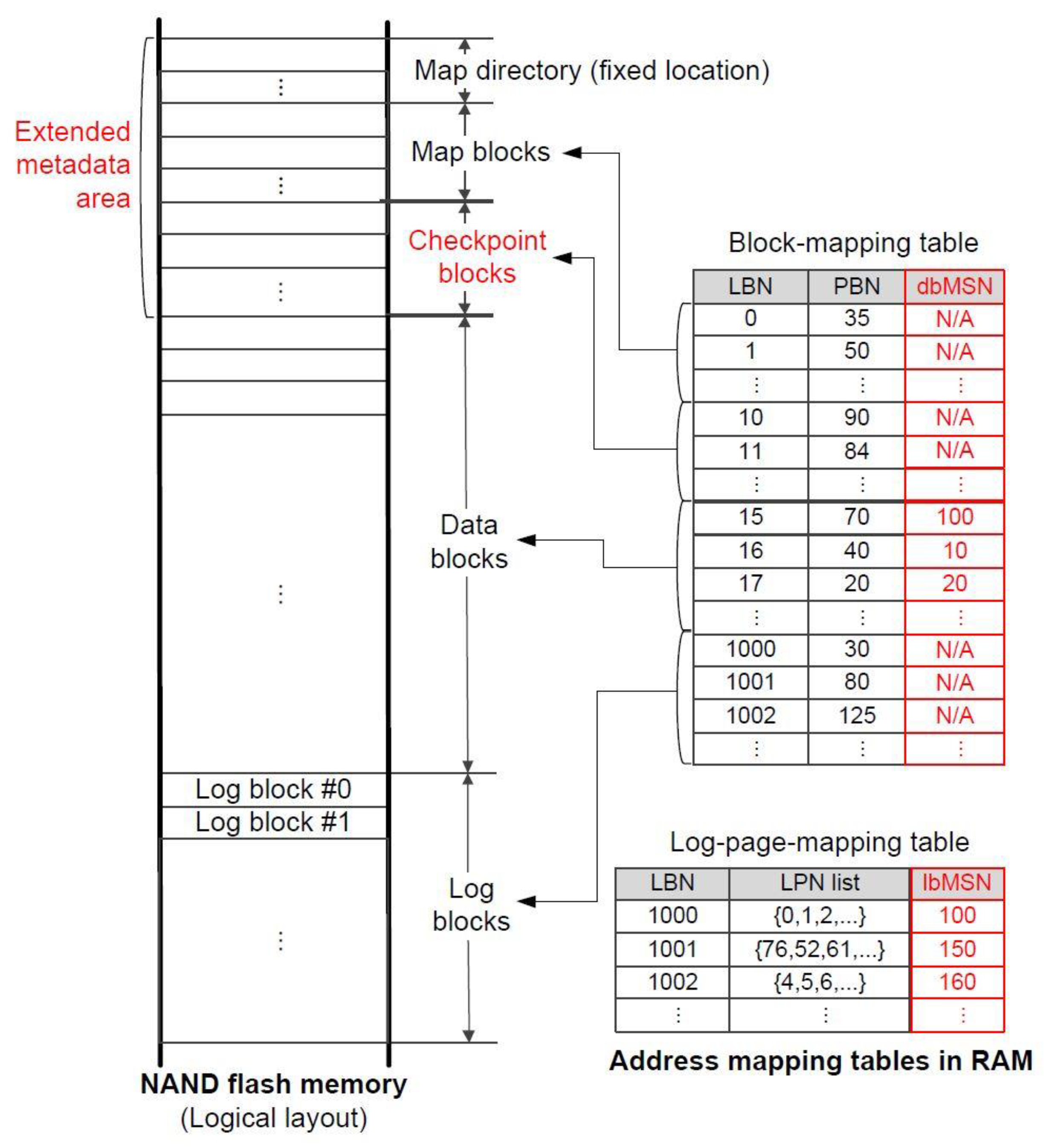


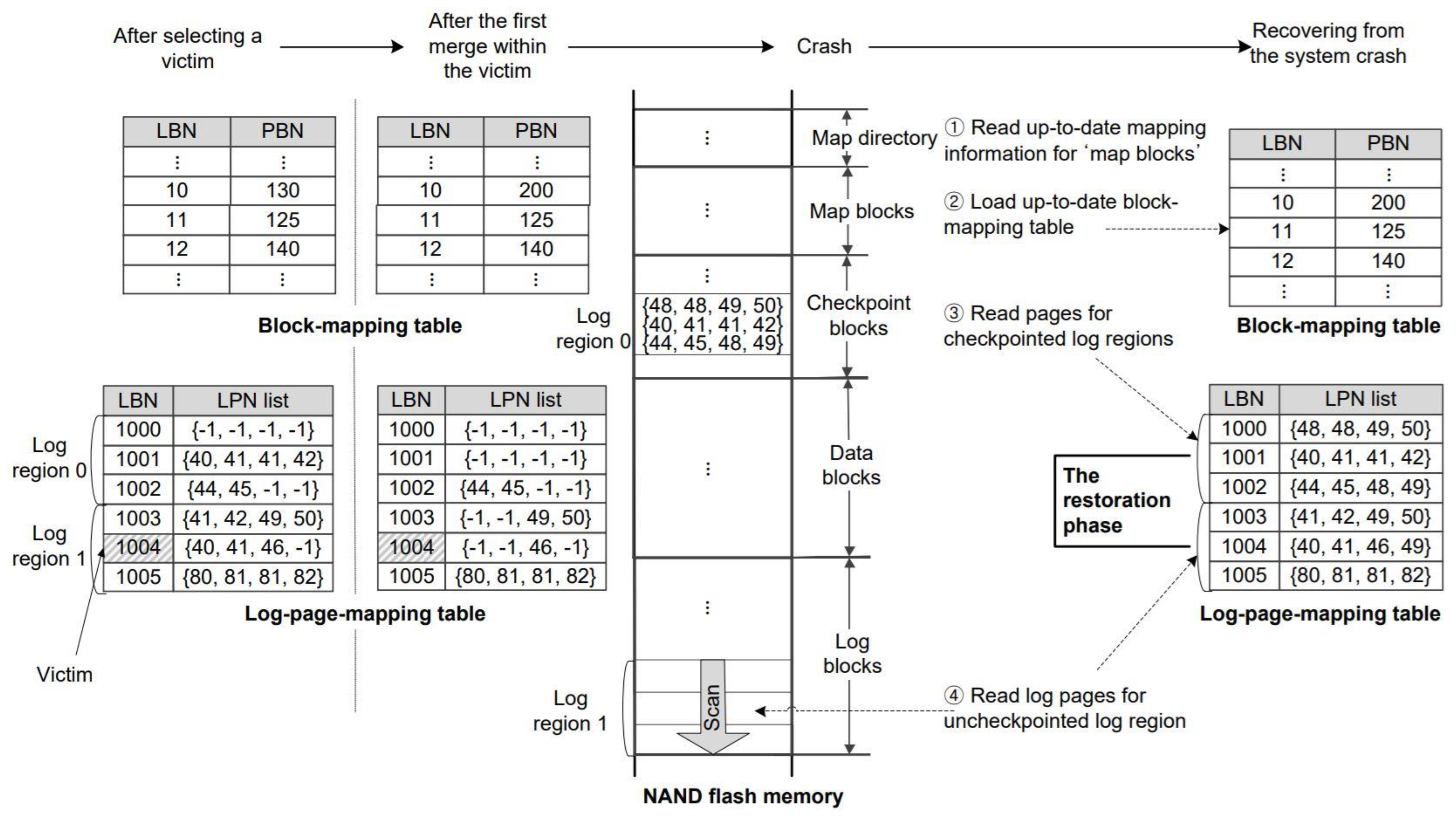
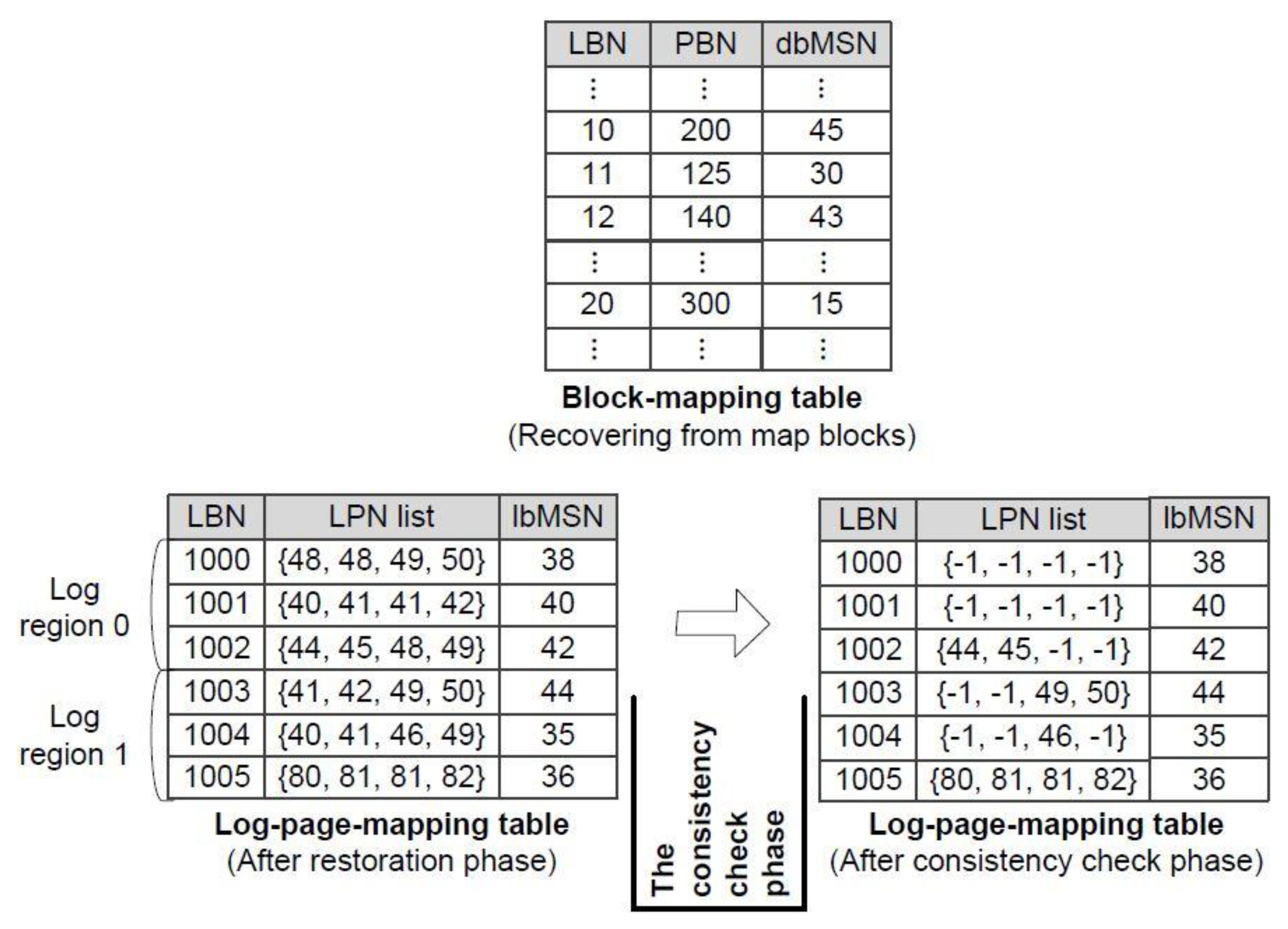

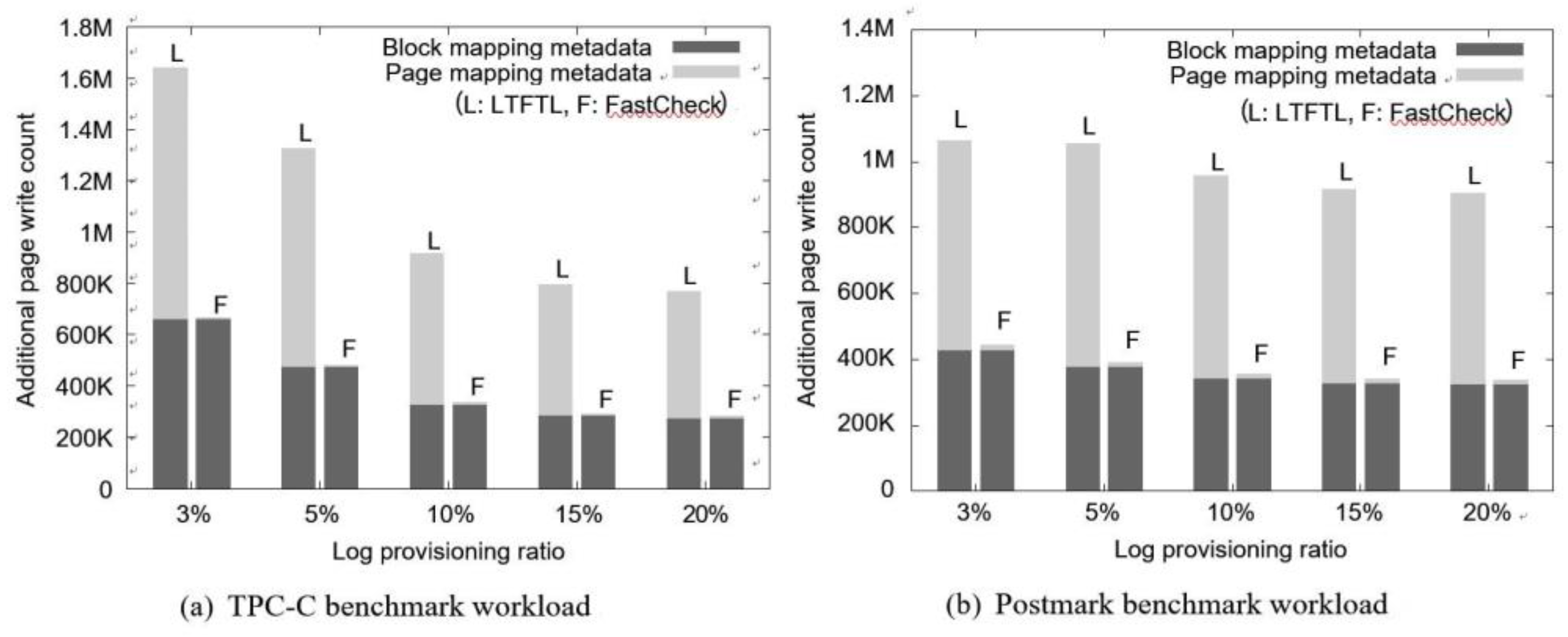
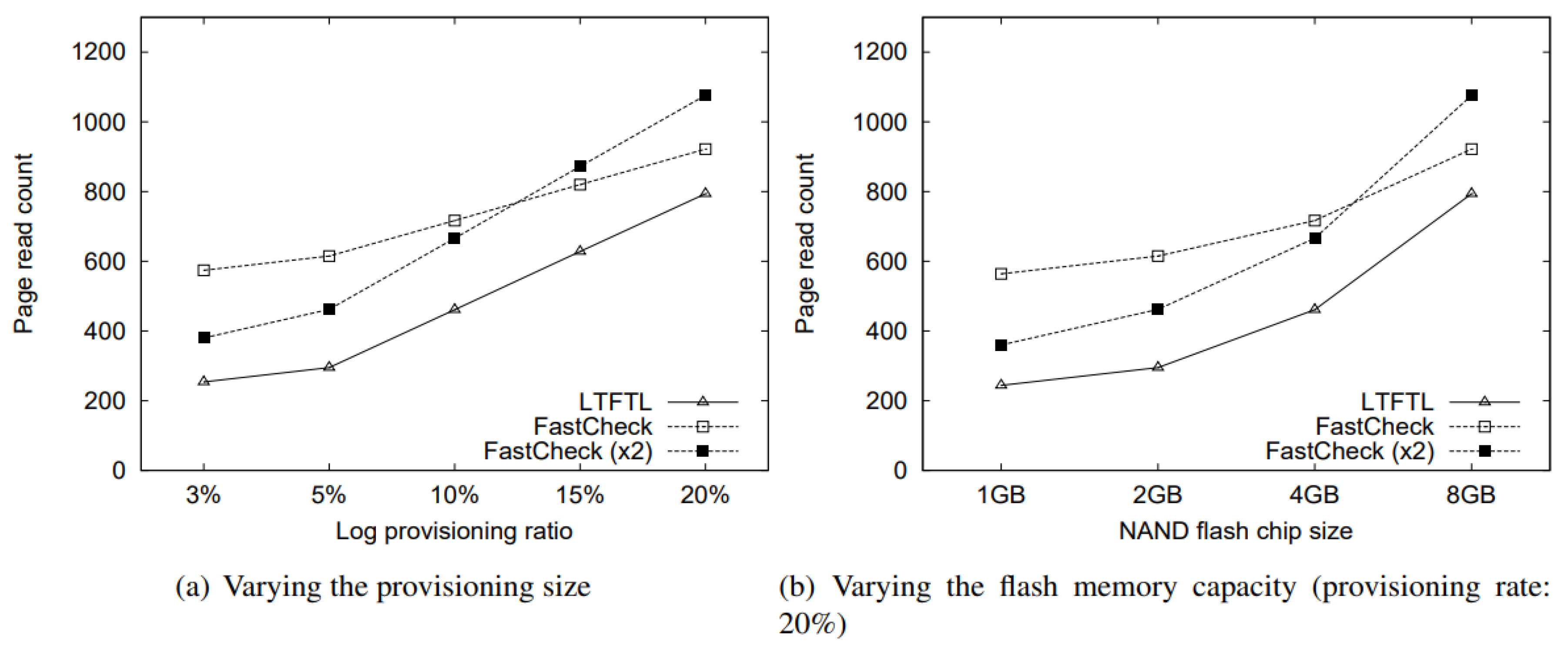
| Notation | Description |
|---|---|
| Cflash | Capacity of the flash memory |
| Llog_rate | Percentage of the log block area to the flash memory |
| Nwrites | Number of write requests from the host |
| Npmap | Number of pages to store a log-page-mapping table |
| Nlog_recs | Number of log records generated by data page writes in LTFTL (Note1) |
| Nlrecs_in_page | Number of log records that a single page can accommodate in LTFTL |
| Nlr_threshold | Threshold value of the number of log records allowable in LTFTL (Note2) |
| Pltftl | Checkpoint period in pages for the log records in LTFTL (Note3) |
| Pfastcheck | Checkpoint period in pages for the log-page-mapping table in FastCheck (Note4) |
Publisher’s Note: MDPI stays neutral with regard to jurisdictional claims in published maps and institutional affiliations. |
© 2021 by the authors. Licensee MDPI, Basel, Switzerland. This article is an open access article distributed under the terms and conditions of the Creative Commons Attribution (CC BY) license (http://creativecommons.org/licenses/by/4.0/).
Share and Cite
Park, J.-H.; Park, D.-J.; Chung, T.-S.; Lee, S.-W. A Crash Recovery Scheme for a Hybrid Mapping FTL in NAND Flash Storage Devices. Electronics 2021, 10, 327. https://doi.org/10.3390/electronics10030327
Park J-H, Park D-J, Chung T-S, Lee S-W. A Crash Recovery Scheme for a Hybrid Mapping FTL in NAND Flash Storage Devices. Electronics. 2021; 10(3):327. https://doi.org/10.3390/electronics10030327
Chicago/Turabian StylePark, Jong-Hyeok, Dong-Joo Park, Tae-Sun Chung, and Sang-Won Lee. 2021. "A Crash Recovery Scheme for a Hybrid Mapping FTL in NAND Flash Storage Devices" Electronics 10, no. 3: 327. https://doi.org/10.3390/electronics10030327
APA StylePark, J.-H., Park, D.-J., Chung, T.-S., & Lee, S.-W. (2021). A Crash Recovery Scheme for a Hybrid Mapping FTL in NAND Flash Storage Devices. Electronics, 10(3), 327. https://doi.org/10.3390/electronics10030327








